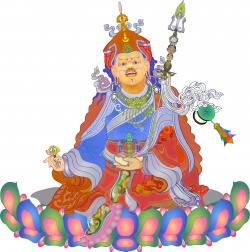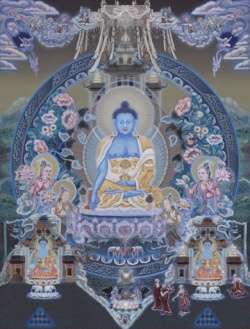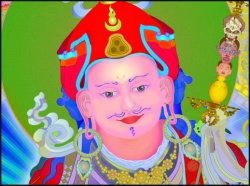Golden Letters
According to the ancient traditions of the Nyingmapa school of Tibetan Buddhism, the central teachings of dzogchen, "the Great Perfection," were first expounded in the human world by the great Buddhist master Garab Dorje from the mysterious country of Uddiyana (Eastern Afghanistan).
This core Buddhist teaching directly introduces the meditation practitioner to the Nature of Mind, or innate Buddha-nature, which has been there from the very beginning, since before Samsara itself came into manifestation, but which goes unrecognized lifetime after lifetime because it is covered over by adventitious obscurations and negative karma.
The practice of dzogchen purifies and removes these layers of the clouds of obscuration an d karma, so that one's own original nature, intrinsic awareness or Rigpa, shines through like the face of the sun in the sky free of clouds.
From Uddiyana, the Dzogchen teachings were brought to India by Manjushrimitra and, in turn, his disciple Shrisimha transmitted them to three students, Padmasambhava, Vimalamitra, and Vairochana the Tibetan translator, who brought them to Tibet.
Since then these Dzogchen teachings have been preserved and propagated within the traditions of the nyingmapa school of Tibet established by Guru Padmasambhava in the eighth century of our era.
The essence of Garab Dorje's message or kerygma is found in his last testament delivered to Manjushrimitra after the master had passed into Nirvana by way of attaining the Rainbow Body of Light, the culmination of the practice of Dzogchen.
Having dissolved his physical body into pure radiant energy and fading into the clear open spaces of the sky, he reappeared as a resurrected Body of Light in the guise of a sixteen year old youth inside a rainbow sphere of light suspended in the middle of the cloudless sky.
This last testament or final posthumous communication ('das-rjes) is known as "The Three Statements that Strike the Essential Points," (Tshig gsum gnad brdeg), and represents the quintessence of the Dzogchen teachings.
In the nineteenth century in Eastern Tibet, the famous master Patrul Rinpoche wrote a brilliant commentary on these three statements, together with the contemplation practices relating to them, entitled "The Special Teachings of the Wise and Glorious King," (mKas-pa shri rgyal-po' khyad chos). In this volume these important Dzogchen texts of Garab Dorje and Patrul Rinpoche are translated from the Tibetan into contemporary English. Notes, commentaries, and glossary of Dzogchen terms are also included.
Translation Of The Last Testament Of Garab Dorje:
The Last Testament of Garab Dorje: "The Three Statements that Strike the Essential Points ' from "The Posthumous Teachings of the Vidyadharas."
NAMO GURUVE!
Homage to that confidence deriving from understanding one's own state of immediate intrinsic Awareness!
This state of immediate intrinsic Awareness (called Rigpa) is uncreated and self-existing.
Its mode of being represents the essence that is the primordial Base. Everywhere the manner in which it arises in response to external appearances, which are themselves diverse, is uninterrupted and unobstructed.
Moreover, all the phenomena that appear and that exist, arise (spontaneously self-perfected) within the field of the Dharmakaya. Whatever appearances may manifest therein are directly liberated after their arising due to the presence of one's own state of immediate Awareness (rig-pa).
As for the real meaning of this: All of the enlightened states, which consist of non-dual knowledge that is primordial awareness (ye-shes), present within the hears of all the Sugatas are, in fact,encompassed within this single unique state of immediate intrinsic Awareness found within every individual sentient being.
In order to inspire Manjushrimitra, who had fallen down senseless upon the ground (when his master had dissolved his physical body into space at the end of his life), this Upadesha, or secret oral instruction, consisting of "The Three Statements that Strike the Essential points," was revealed by the master Garab Dorje.
For the purpose of eliminating all concepts relating to both Samsara and Nirvana (in the mind of his disciple), that is to say, his believing that either of them are actual self-existent in their own terms, this exceeding excellent and well-demonstrated last testament was revealed at the time of the master's death (and resurrection).
It should be concealed and preserved within one's own innermost heart! A!
Indeed, this state of immediate intrinsic Awareness is beyond all conception (by the intellect), being something uncreated and unconditioned. ATI!
This Upadesha, which unhesitatingly reveals the state of immediate intrinsic Awareness, which represents the capacity of the Primordial Base that is the Dharmakaya, is as follows:
"One is directly introduced to one's own rel nature," that is to say, one is introduced directly and ultimately to one's own real face or nature that is intrinsic Awareness, the state of immediate pure presence (rig-pa).
And, furthermore, its nature is revealed, in actuality, to be completely pure from the very beginning (ka-dag).
It is just this state of immediate Awareness that is introduced here, in the same way, as for example, that anger (when faced and recognized) can be liberated by itself.
"One directly decided upon this single unique state," that is to say, one discovers directly for oneself, (in the midst of a multitude of diverse experiences), this single and unique state of intrinsic Awareness, wherein one is aware in every respect, without there being any sense of duality of of subject and object remaining.
"One then directly continues with confidence in liberation," that is to say, one continues, directly in the state of contemplation with full confidence in the automatic (and effortless) process of self-liberation (of whatever thoughts and appearances arise).
And, because of that, one's own Awareness finds itself inherently liberated on its own (without any intervention by the discursive intellect or by anything outside of itself).
There exists no single sentient being who, in terms of the elf-manifesting of this in intrinsic Awareness, does not find him- or herself inherently liberated.
One's own individual state of existence (or condition of interior awareness), on the one hand, and the states of other things in the outer world which are presented to one's consciousness as external appearances, on the other hand, come to encounter each other and become integrated.
(This represents a direct immediate intuition without there being any duality of subject and object, a primordial awareness or ye-shes)
But, where this is not understood by the individual, then oneself and other things (the "I", which is one's own interior awareness, and the "others", which are external appearances)are perceived as arising in a dualisitic (and Cartesian) fashion of interior subject and external object.
This single Upadesha, or secret oral instruction (given above), for self-liberation in an immediate and straightforward fashion is unique (among all the spiritual paths to enlightenment), and its contrary does not exist anywhere (in terms of efficacy). It alone is sufficient for liberation. ATI!
Excerpted from The Golden Letters by John Myrdhin Reynolds
Being an Introduction to the Nature of One's Own Mind from "The Profound Teaching of Self-Liberation in the Primordial State of the Peaceful and Wrathful Deities,"
A Terma Text of Guru Padmasambhava expounding the View of Dzogchen, and Rediscovered by Rigdzin Karma Lingpa; Foreword by Namkhai Norbu Rinpoche, Translated with Introduction and Notes by John Myrdhin Reynolds, New Edition by Snow Lion Publications, Ithaca NY, 2000. The Three Statements of Garab Dorje, the First Human Teacher of Dzogchen,
together with a Commentary by Dza Patrul Rinpoche entitled "The Special Teaching of the Wise and Glorious King;"
Foreword by Namkhai Norbu Rinpoche, A Short Commentary on the Three Statements by HH Dudjom Rinpoche, Translation, Introduction, and Commentaries by John Myrdhin Reynolds, Snow Lion Publications, Ithaca, New York, 1996.




